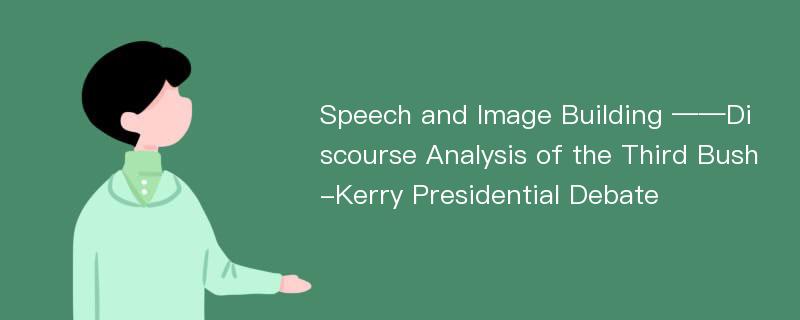
论文摘要
本文是典型的应用型个案研究,是从功能语言学和社会语言学的角度,对第三次布什-克里总统辩论进行话语分析。文章试图揭示讲话模式与形象塑造的关系。首先,文章简单介绍了话语分析的历史和第三次布什-克里总统辩论的背景知识。文章回顾了主要运用的三个重要的理论。这三个理论是吉的社会、认知的话语分析方法,韩礼德的功能语法中的人际功能和哈得森的面子、共聚量和适应理论。然后,文章对进行的研究加以阐述。文章调查了布什和克里的背景并引用了一些关于他们总统辩论的公开报道。在此基础上,文章提出了一个假设。假设在第三次布什-克里总统辩论中,布什和克里分别塑造了‘实干家’和‘思想者’的形象。研究对布什和克里的辩论讲话的语言细节进行了定量和定性调查。调查的语言细节包括言语功能实现、时态助动词、情态助动词、Ⅰ-语句、语气状语、呼格和称呼以及感叹词和言语填充词。接下来,文章罗列出了对语言细节的研究结果。并对罗列出了语言细节的研究结果逐一加以诠释和深入分析。诠释包括布什和克里话语的对比分析和举例说明。调查和解释揭示布什和克里的不同言语模式和个人特点。“实干家”和“思想者”两词有不同的情景意义和文化模式。“实干家”是那些普通人,如飞行员、电工、木匠、管子工、屠夫等;“思想者”是那些受教育较高的人,如律师、法官、教授、历史学家、数学家等。在辩论中,布什和克里塑造了不同的社会情景身份。布什讲话像普通美国人,而克里讲话像受教育程度较高的美国人。因为有不同的谈话方式,布什和克里分别塑造“实干家”和“思想者”的形象。在辩论中,因为布什和克里的讲话方式不同,可以认为他们在进行不同的活动。布什就好像是在和普通美国人拉家常,而克里则是在受教育程度较高的美国人前面发表演讲。他们在适应不同的目标听众,并实现和他们的共聚量关系。最后,文章总结了研究的发现、意义和局限。本文从一定程度上部分的说明了在2004美国总统竞选中布什成功当选连任和克里在竞选运动中表现强劲结果却以失败告终的原因。对话语和形象意识很强的人来说,本文也有一定的实际意义,可以指导他们有意识地使用言语以建立良好的个人形象。
论文目录
Abstract摘要Chapter 1 Introduction1.1 Discourse analysis proper1.2 The US presidential debates1.3 Speech and image building1.4 Thesis structureChapter 2 Literature Review2.1 Social and cognitive discourse analysis: theoretical base2.1.1 Tools of inquiry2.1.2 Six buildings2.2 Interpersonal function: tool of inquiry into linguistic details2.2.1 Speech functions2.2.2 Mood2.3 Social functions of discourse: analytical perspective2.3.1 Face2.3.2 Solidarity and accommodationChapter 3 Research Design of the Third Bush-Kerry Presidential Debate3.1 Profiles of Bush and Kerry3.2 Hypothesis3.3 Research methods3.4 Data collectionChapter 4 Research Results and Data Interpretation of the Third Bush-Kerry Presidential Debate4.1 Speech function realization4.1.1 Research results4.1.2 Data interpretation4.2 Temporal operators4.2.1 Research results4.2.2 Data interpretation4.3 Model operators4.3.1 Research Results4.3.2 Data interpretation4.4 I-statements4.4.1 Research Results4.4.2 Data interpretation4.5 Mood adjuncts4.5.1 Research Results4.5.2 Data Interpretation4.6 Vocatives and address forms4.6.1 Research Results4.6.2 Data interpretation4.7 Expletives and speech fillers4.7.1 Research Results4.7.2 Data interpretationChapter 5 Further Analysis of Image building Realization5.1 Bush's and Kerry's speech patterns5.2 Situated meanings of "doer" and "thinker"5.3 Cultural models of "doer" and "thinker"5.4 Six buildings in Bush's and Kerry's debate speech5.5 Bush's and Kerry's image building in their debate speech5.6 Solidarity and accommodation realizationChapter 6 Conclusion6.1 Findings6.2 Significance6.3 LimitationsBibliographyAppendix作者攻硕期间取得的成果个人简历
相关论文文献
标签:讲话论文; 形象塑造论文; 话语分析论文; 人际功能论文; 美国总统竞选辩论论文;
Speech and Image Building ——Discourse Analysis of the Third Bush-Kerry Presidential Debate
下载Doc文档
